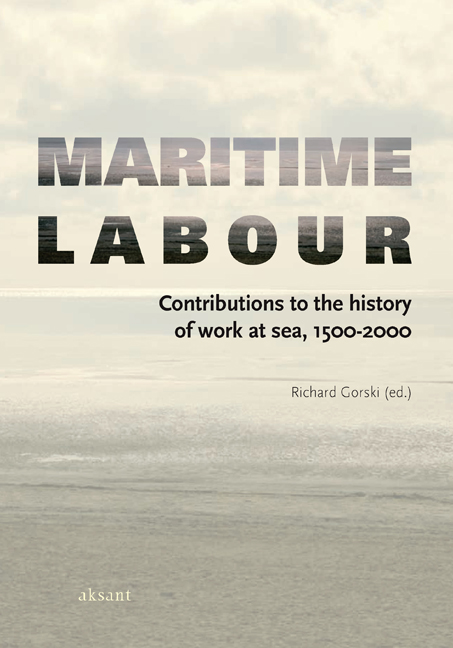Book contents
- Frontmatter
- Contents
- Introduction
- Six Cross-sections of the Dutch Maritime Labour Market: A Preliminary Reconstruction and its Implications (1610-1850)
- On Maritime Labour and Maritime Labour Markets in Germany, 1700-1900
- Swedish Naval Personnel in the Merchant Marine and in Foreign Naval Service in the Eighteenth Century
- Quantifying British Seafarers, 1789-1828
- ‘But for the Loves of the Fishes’: Maritime Labour and Ecological Culture in Nineteenth-century Newfoundland
- The Shipping Federation and the Free Labour Movement: A Comparative Study of Waterfront and Maritime Industrial Relations, c.1889-1891
- Health and Safety Aboard British Merchant Ships: The Case of First Aid Instruction, 1881-1908
- British Merchant Marine Engineer Licensing, 1865-1925
- Transatlantic Fishers: New England and British Trawlermen, 1960-1972
- Masters and chiefs: Enabling globalization, 1975-1995
- About the Contributors
The Shipping Federation and the Free Labour Movement: A Comparative Study of Waterfront and Maritime Industrial Relations, c.1889-1891
Published online by Cambridge University Press: 26 January 2021
- Frontmatter
- Contents
- Introduction
- Six Cross-sections of the Dutch Maritime Labour Market: A Preliminary Reconstruction and its Implications (1610-1850)
- On Maritime Labour and Maritime Labour Markets in Germany, 1700-1900
- Swedish Naval Personnel in the Merchant Marine and in Foreign Naval Service in the Eighteenth Century
- Quantifying British Seafarers, 1789-1828
- ‘But for the Loves of the Fishes’: Maritime Labour and Ecological Culture in Nineteenth-century Newfoundland
- The Shipping Federation and the Free Labour Movement: A Comparative Study of Waterfront and Maritime Industrial Relations, c.1889-1891
- Health and Safety Aboard British Merchant Ships: The Case of First Aid Instruction, 1881-1908
- British Merchant Marine Engineer Licensing, 1865-1925
- Transatlantic Fishers: New England and British Trawlermen, 1960-1972
- Masters and chiefs: Enabling globalization, 1975-1995
- About the Contributors
Summary
Waterfront and maritime trade unionism c.1850-1891: The Scottish context
It was Sydney and Beatrice Webb who suggested that the ‘new unionism’ of the late 1880s and early 1890s was a different type of trade unionism and since then historians have come to accept this view of ‘new directions in industrial relations’. Indeed, as it was linked to the organization of unskilled workers and because of its connections with the socialist movement many historians have read into it ‘evidence of a new class consciousnesses’. Moreover, it was commonly held that the impulse for this movement was historically linked with the London dock strike of August 1889, or at the very earliest the strike of match girls during the previous summer. It was therefore a movement that had its roots in London: ‘a view that – although highly persistent – has long been untenable’ – and particularly so in the Scottish context.
Engels argued at the time of the London dock strike that if the dockers could organize themselves then other sections of workers would follow, and in the aftermath of the strike Harry Quelch, of the London South Side Labour Protection League, wrote how this dispute created ‘the impetus and enthusiasm for combination among large numbers of workers hitherto unorganized’. In Scotland, however, organizations of dockers, seamen, carters and porters had been evident long before the London strike. The artisan phase of early dock unionism began with the emergence of the Glasgow Harbour Labourers’ Union (GHLU) in 1853; the transition to a more general type of dock unionism came with the formation of the Aberdeen Shore Workers’ Union in 1883, and later the Greenock Dock Labourers’ Union and the Glasgow Harbour Mineral Workers’ Union (GHMWU) both formed in 1887; and in 1886 the Clyde Associated Mariners’ Society was established at Glasgow (a year before the formation of the National Amalgamated Sailors’ and Firemen's Union (NASFU) in 1887). But these were essentially local trade union societies and not national organizations.
The first mass general dock unions did not emerge until the late 1880s, and in Scotland by early February 1889 the Glasgow Herald reported that Glasgow dockers had formed the National Union of Dock Labourers (NUDL).
- Type
- Chapter
- Information
- Maritime LabourContributions to the History of Work at Sea, 1500–2000, pp. 129 - 154Publisher: Amsterdam University PressPrint publication year: 2008



